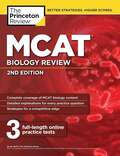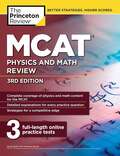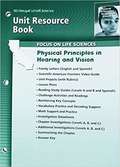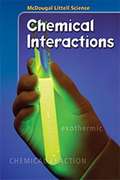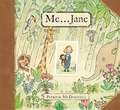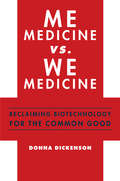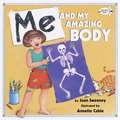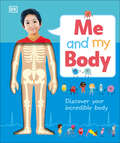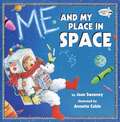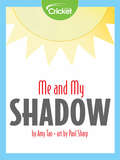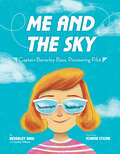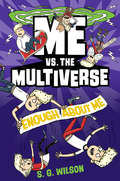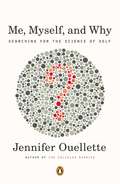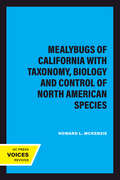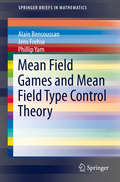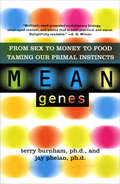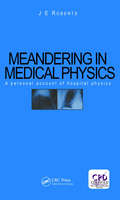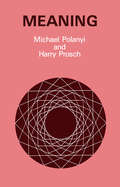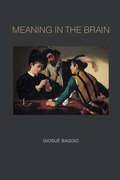- Table View
- List View
Mcat Biology Review, 2nd Edition
by The Princeton The Princeton ReviewMake sure you’re studying with the most up-to-date prep materials! Look for the newest edition of this title, The Princeton Review MCAT Biology Review, 3rd Edition (ISBN: 9780593516232, on-sale November 2022). Publisher's Note: Products purchased from third-party sellers are not guaranteed by the publisher for quality or authenticity, and may not include access to online tests or materials included with the original product.
Mcat Physics And Math Review, 3rd Edition
by The Princeton The Princeton ReviewMCAT Physics and Math Review, 3rd Edition (Graduate School Test Preparation)
Mcdougal Littell Science California: Physical Principles in Hearing and Vision Unit Resource Book, Grade 7, Life Science
by McDougal LittelMcdougal Littell Science: Chemical Interactions (Grades 6-8)
by Rita Ann Calvo Kenneth Cutler James TrefilIn the simplest terms, physical science is the study of what things are made of and how they change. It combines the studies of both physics and chemistry. Physics is the science of matter, energy, and forces. It includes the study of topics such as motion, light, and electricity and magnetism. Chemistry is the study of the structure and properties of matter, and it especially focuses on how substances change into different substances.
Mcgraw - Hill Science (Grade 4, Texas edition)
by Lucy Daniel Joanne Vasquez Jay Hackett Richard Moyer Pamela Stryker Prentice BaptisteScientists study books and articles to find out facts. They also ask questions. They always try to test their ideas for themselves.
Mcknight's Physical Geography: A Landscape Appreciation 11th Ed
by Dennis G. Tasa Darrel HessContinuing Tom L. McKnight's well-known thematic focus on landscape appreciation, Darrel Hess offers a broad survey of all of the physical processes and spatial patterns that create Earth's physical landscape. McKnight's Physical Geography: A Landscape Appreciation provides a clear writing style, superior art program, and abundant pedagogy to appeal to a wide variety of students. This new edition offers a truly meaningful integration of visualization, technology, the latest applied science, and new pedagogy, providing essential tools and opportunities to teach and engage students in these processes and patterns.
Me ... Jane
by Patrick McdonnellThe "New York Times"-bestselling author of "The Gift of Nothing" presents an inspiring story of the young Jane Goodall and her special childhood toy chimpanzee. With anecdotes taken directly from Goodall's autobiography, McDonnell makes this very true story accessible for the very young.
Me Medicine vs. We Medicine: Reclaiming Biotechnology for the Common Good
by Donna DickensonPersonalized healthcare—or what the award-winning author Donna Dickenson calls "Me Medicine"—is radically transforming our longstanding "one-size-fits-all" model. Technologies such as direct-to-consumer genetic testing, pharmacogenetically developed therapies in cancer care, private umbilical cord blood banking, and neurocognitive enhancement claim to cater to an individual's specific biological character, and, in some cases, these technologies have shown powerful potential. Yet in others they have produced negligible or even negative results. Whatever is behind the rise of Me Medicine, it isn't just science. So why is Me Medicine rapidly edging out We Medicine, and how has our commitment to our collective health suffered as a result? In her cogent, provocative analysis, Dickenson examines the economic and political factors fueling the Me Medicine phenomenon and explores how, over time, this paradigm shift in how we approach our health might damage our individual and collective well-being. Historically, the measures of "We Medicine," such as vaccination and investment in public-health infrastructure, have radically extended our life spans, and Dickenson argues we've lost sight of that truth in our enthusiasm for "Me Medicine." Dickenson explores how personalized medicine illustrates capitalism's protean capacity for creating new products and markets where none existed before—and how this, rather than scientific plausibility, goes a long way toward explaining private umbilical cord blood banks and retail genetics. Drawing on the latest findings from leading scientists, social scientists, and political analysts, she critically examines four possible hypotheses driving our Me Medicine moment: a growing sense of threat; a wave of patient narcissism; corporate interests driving new niche markets; and the dominance of personal choice as a cultural value. She concludes with insights from political theory that emphasize a conception of the commons and the steps we can take to restore its value to modern biotechnology.
Me and My Amazing Body
by Joan SweeneyA girl describes how her skin, bones, muscles, brain, blood, heart, lungs, and stomach receive energy and function as parts of her body.
Me and My Body
by DKAmazing facts come together with fun, easy-to-do crafts in this STEAM-centric celebration of the human body.Learn amazing facts like how germs can make you sick, why you have a belly button, and how your senses work. Then create wonderful crafts, like a beautiful family tree, a homemade stethoscope, and gingerbread skeletons, combining reading skills, STEAM concepts, and hands-on family fun. Discover what a family tree is, then create one yourself. Explore your amazing fingerprints, then decorate a beautiful picture frame with them. Make a paper skeleton or play a game about digestion. This is a perfect package for a little learner who wants to know all about what's going on inside their body!
Me and My Place in Space
by Joan Sweeney<p>Where is the earth? Where is the sun? Where are the stars? <p>Now in a Dragonfly edition, here is an out-of-this world introduction to the universe for children. With earth as a starting point, a young astronaut leads readers on a tour past each planet and on to the stars, answering simple questions about our solar system. In clear language, drawings, and diagrams, space unfolds before a child's eyes. Colorful illustrations, filled with fun and detail, give children a lot to look for on every page and a glossary helps reinforce new words and concepts. A terrific teaching tool, Me and My Place in Space is an easy and enjoyable way to introduce the concept of space to the very youngest astronomers.</p>
Me and My Place in Space (Me. . Books! Ser.)
by Joan SweeneyWhere am I in the solar system? A beloved bestseller, now refreshed with new art from Christine Gore, that will help children discover their place in the Milky Way. Where is the earth? Where is the sun? Where are the stars? Now with new art by Christine Gore, here is an out-of-this world introduction to the universe for children. With Earth as a starting point, a young astronaut leads readers on a tour past each planet and on to the stars, answering simple questions about our solar system. In clear language, drawings, and diagrams, space unfolds before a child's eyes. Colorful illustrations, filled with fun detail, give children a lot to look for on every page, and a glossary helps reinforce new words and concepts. A terrific teaching tool, Me and My Place in Space is an easy and enjoyable way to introduce the concept of space to budding astronomers.
Me and My Shadow
by Amy TaoTake a look at your shadow in the sunshine. Try a shadow puppet. Learn how the sun's position in the sky affects your shadow.
Me and the Sky: Captain Beverley Bass, Pioneering Pilot
by Beverley Bass Cynthia WilliamsThe groundbreaking female pilot featured in the hit Broadway musical Come from Away tells her story in this high-flying and inspiring picture-book autobiography!When Beverley Bass was a young girl in the late 1950s, she told her parents she wanted to fly planes--and they told her that girls couldn't be pilots. Still, they encouraged her, and brought her to a nearby airport to watch the planes take off and land.After decades of refusing to take no for an answer, in 1986 Beverley became the first female pilot promoted to captain by American Airlines and led the first all-female crewed flight shortly thereafter. Her revolutionary career became even more newsworthy when she was forced to land in the remote town of Gander, Newfoundland, on September 11, 2001, due to US airspace closures. After several days there, she flew her crew and passengers safely home.Beverley's incredible life is now immortalized in the hit Broadway musical Come from Away. Here, discover how she went from an ambitious young girl gazing up at the sky to a groundbreaking pilot smiling down from the cockpit."Inspiring and up, up, and away all the way."--Kirkus"An inspiring biography about one woman's determination to forge a new path."--Booklist
Me pregunto … Por qué estornudamos y otras cosas (¡Arriba la Lectura!, Level N #90)
by Maureen Mecozzi Lisa Chesters¿Te has preguntado por qué estornudas o por qué te da hipo? Para averiguarlo, lee estas preguntas y respuestas sobre el cuerpo humano. NIMAC-sourced textbook
Me vs. the Multiverse: Enough About Me (Me vs. the Multiverse #2)
by S. G. WilsonCan plain old Average Me fix the rip in the multiverse? The Mes are back in this hilarious second book in the sci-fi comedy series for fans of Stuart Gibb's Moon Base Alpha and quirky animated shows like Rick and Morty and Regular Show.Saving the multiverse starts with another origami note: Make it here, pronto.This time Meade Macon, aka Average Me, knows that parallel dimensions are real. He's met dozens of his counterparts from other Earths. What he doesn't know is that they're all about to get zapped out of existence.On Earth Zero, a rip in the multiverse is spreading to other realities and causing chaos wherever it appears. And the different versions of Meade--the Mes--are caught in the middle! Motor Me, Resist Me, and Hollywood Me just want to go back home to their own Earths. The only way to do that is to repair the rip. Once again, it's up to Average Me! But if Average is going to fix the multiverse, he just might have to team up with his archnemesis . . . Meticulous Me.
Me, Myself, and Why
by Jennifer OuelletteA fascinating tour through the science behind who we are and how we got this way--from the author of The Calculus Diaries As diverse as people appear to be, all of our genes and brains are nearly identical. In Me, Myself, and Why, Jennifer Ouellette dives into the miniscule ranges of variation to understand just what sets us apart. She draws on cutting-edge research in genetics, neuroscience, and psychology--enlivened as always with her signature sense of humor--to explore the mysteries of human identity and behavior. Readers follow her own surprising journey of self-discovery as she has her genome sequenced, her brain mapped, her personality typed, and even samples a popular hallucinogen. Bringing together everything from Mendel's famous pea plant experiments and mutations in The X-Men to our taste for cilantro and our relationships with virtual avatars, Ouellette takes us on an endlessly thrilling and illuminating trip into the science of ourselves.
Mealybugs of California with Taxonomy, Biology and Control of North American Species
by Howard L. McKenzieThis title is part of UC Press's Voices Revived program, which commemorates University of California Press’s mission to seek out and cultivate the brightest minds and give them voice, reach, and impact. Drawing on a backlist dating to 1893, Voices Revived makes high-quality, peer-reviewed scholarship accessible once again using print-on-demand technology. This title was originally published in 1967.This title is part of UC Press's Voices Revived program, which commemorates University of California Press’s mission to seek out and cultivate the brightest minds and give them voice, reach, and impact. Drawing on a backlist dating to 1893, Voices Revived</DIV
Mean Field Games and Mean Field Type Control Theory
by Alain Bensoussan Jens Frehse Phillip YamMean field games and Mean field type control introduce new problems in Control Theory. The terminology "games" may be confusing. In fact they are control problems, in the sense that one is interested in a single decision maker, whom we can call the representative agent. However, these problems are not standard, since both the evolution of the state and the objective functional is influenced but terms which are not directly related to the state or the control of the decision maker. They are however, indirectly related to him, in the sense that they model a very large community of agents similar to the representative agent. All the agents behave similarly and impact the representative agent. However, because of the large number an aggregation effect takes place. The interesting consequence is that the impact of the community can be modeled by a mean field term, but when this is done, the problem is reduced to a control problem.
Mean Genes: From Sex To Money To Food: Taming Our Primal Instincts
by Jay Phelan Terry BurnhamWhy do we want--and why do we do--so many things that are bad for us? And how can we stop? In Mean Genes economist Terry Burnham and biologist Jay Phelan offer advice on how to conquer our own worst enemy--our survival-minded genes. Having evolved in a time of scarcity, when our ancestors struggled to survive in the wild, our genes are poorly adapted to the convenience of modern society. They compel us to overeat, spend our whole paycheck, and cheat on our spouses. But knowing how they work, Burnham and Phelan show that we can trick these "mean genes" into submission and cultivate behaviors that will help us lead better lives. A lively, humorous guide to our evolutionary heritage, Mean Genes illuminates how we can use an understanding of our biology to beat our instincts--before they beat us.
Mean and Lowly Things: Snakes, Science, and Survival in the Congo
by Kate JacksonIn 2005 Kate Jackson ventured into the remote swamp forests of the northern Congo to collect reptiles and amphibians. Her camping equipment was rudimentary, her knowledge of Congolese customs even more so. She knew how to string a net and set a pitfall trap, but she never imagined the physical and cultural difficulties that awaited her. Culled from the mud-spattered pages of her journals, Mean and Lowly Things reads like a fast-paced adventure story. It is Jackson’s unvarnished account of her research on the front lines of the global biodiversity crisis—coping with interminable delays in obtaining permits, learning to outrun advancing army ants, subsisting on a diet of Spam and manioc, and ultimately falling in love with the strangely beautiful flooded forest. The reptile fauna of the Republic of Congo was all but undescribed, and Jackson’s mission was to carry out the most basic study of the amphibians and reptiles of the swamp forest: to create a simple list of the species that exist there—a crucial first step toward efforts to protect them. When the snakes evaded her carefully set traps, Jackson enlisted people from the villages to bring her specimens. She trained her guide to tag frogs and skinks and to fix them in formalin. As her expensive camera rusted and her Western soap melted, Jackson learned what it took to swim with the snakes—and that there’s a right way and a wrong way to get a baby cobra out of a bottle.
Meandering in Medical Physics: A personal account of hospital physics
by J.E RobertsWhen Professor J.E. Roberts was first employed at the then Cancer Hospital (Free) in 1932, the words medical and physics were rarely joined together. Meandering in Medical Physics presents an account of Professor Roberts's experiences in professional life, both in the United Kingdom and overseas. It documents the early history of medical physics and provides insight into the very basic equipment and working conditions well known to hospital physicists not long ago. Enhanced by archived photographs from the British Institute of Radiology, this fascinating fireside read (European Radiology) will entertain, enlighten, and educate.
Meaning
by Michael Polanyi Harry ProschPublished very shortly before his death in February 1976, Meaning is the culmination of Michael Polanyi's philosophic endeavors. With the assistance of Harry Prosch, Polanyi goes beyond his earlier critique of scientific "objectivity" to investigate meaning as founded upon the imaginative and creative faculties. Establishing that science is an inherently normative form of knowledge and that society gives meaning to science instead of being given the "truth" by science, Polanyi contends here that the foundation of meaning is the creative imagination. Largely through metaphorical expression in poetry, art, myth, and religion, the imagination is used to synthesize the otherwise chaotic and disparate elements of life. To Polanyi these integrations stand with those of science as equally valid modes of knowledge. He hopes this view of the foundation of meaning will restore validity to the traditional ideas that were undercut by modern science. Polanyi also outlines the general conditions of a free society that encourage varied approaches to truth, and includes an illuminating discussion of how to restore, to modern minds, the possibility for the acceptance of religion.
Meaning in the Brain (The\mit Press Ser.)
by Giosue BaggioAn argument that the meaning of written or auditory linguistic signals is not derived from the input but results from the brain's internal construction process.When we read a text or listen to speech, meaning seems to be given to us instantaneously, as if it were part of the input. In Meaning in the Brain, Giosuè Baggio explains that this is an illusion created by the tremendous speed at which sensory systems and systems for meaning and grammar operate in the brain. Meaning, Baggio argues, is not derived from input but results from the brain's internal construction process. With this book, Baggio offers the first integrated, multilevel theory of semantics in the brain, describing how meaning is generated during language comprehension, production, and acquisition. Baggio's theory draws on recent advances in formal semantics and pragmatics, including vector-space semantics, discourse representation theory, and signaling game theory. It is designed to explain a growing body of experimental results on semantic processing that have accumulated in the absence of a unifying theory since the introduction of electrophysiology and neuroimaging methods.Baggio argues that there is evidence for the existence of three semantic systems in the brain—relational semantics, interpretive semantics, and evolutionary semantics—and he discusses each in turn, developing neural theories of meaning for all three. Moreover, in the course of his argument, Baggio addresses several long-standing issues in the neuroscience of language, including the role of compositionality as a principle of meaning construction in the brain, the role of sensory-motor processes in language comprehension, and the neural and evolutionary links among meaning, consciousness, sociality, and action.
